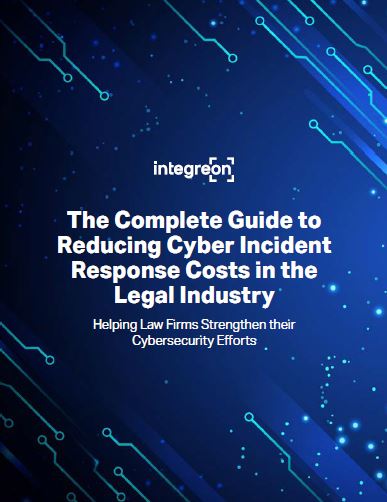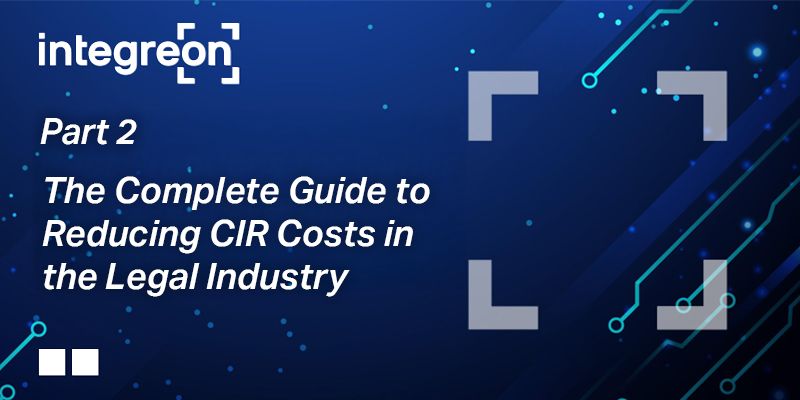This is Part 2 of a 2-part series titled The Complete Guide to Reducing Cyber Incident Response Costs in the Legal Industry. Download the guide here.
According to a recent IBM study, the cost of a data breach is the highest it has ever been, with 75% of the increase being due to the cost of lost business and post-breach response activities.
The lesson? Investing in post-breach response preparedness can help dramatically lower breach costs. Below we break down five things law firms should do now to best recover from a cyber incident.
1. Have a cyber incident response plan
A cyber incident response plan (CIRP) can help prepare, guide, and protect a firm during and after a cyber incident. Based on a report by Ponemon Institute, companies without a formal CIRP pay 58% more per breach compared to those with structured, tested response protocols. Yet, according to the ABA, only 34% of law firms have an incident response plan in place.
All CIRP plans should include the following efforts:
- Define the purpose of the plan and the types of cyber incidents it covers (data breaches, ransomware, phishing attacks, etc.).
- Define the roles and responsibilities of the team, including internal members (IT, PR, HR, etc.) and external partners like cybersecurity consultants.
- Establish criteria for categorizing incidents by severity and impact.
- Develop a framework for how to identify and report potential incidents (monitoring tools, employee reporting procedures, etc.).
- Outline step-by-step procedures to contain, eradicate, and recover from an incident, including specific protocols for diverse types of incidents.
- Define internal and external communication strategies during an incident, including templates for notifying stakeholders, clients, and regulatory bodies.
- Address regulatory requirements (GDPR, CCPA, etc.) for reporting incidents and preserving evidence.
- Outline steps to restore systems and data to normal operations, including a post-incident review process to identify lessons learned and improve the plan.
- Detail regular training programs for employees and the incident response team. Include simulated tabletop exercises to test the plan.
- List the tools, technologies, and resources in use across the firm (firewalls, SIEM systems, etc.).
- Define a schedule for reviewing and updating the plan to ensure it remains current with evolving threats and organizational changes.
2. Outline clear data management processes
Effective data management begins with establishing clear and streamlined processes. Start by decluttering your data collection methods. This ensures you are only gathering what is necessary. Excessive or irrelevant data can slow down operations and inflate storage costs unnecessarily.
By focusing on quality over quantity, you can classify and track data more efficiently, maintaining an organized system that allows for faster access and better decision-making.
3. Encourage cross-team collaboration
Cross-team collaboration is another critical component of robust data management. Encouraging your firm’s IT and InfoSec teams to work closely ensures data security and infrastructure remain top priorities throughout the management process. Legal and communications teams should also be engaged regularly to align with compliance standards and maintain transparency. By breaking down silos and fostering collaboration, businesses can create a unified approach to data management that minimizes risks.
4. Purchase a comprehensive cyber insurance policy
Understanding Cyber Insurance Coverage is another essential part of a viable Cyber Incident Response Plan. When doing your pre-purchase research, look for coverage for breach response, data restoration, privacy breach notification costs, and data privacy litigation coverage. Some cyber policies offer “Outside the Aggregate Limit” breach response coverage, which preserves the policy aggregate limit for class action litigation and other high-exposure risk profiles.
5. Follow correct data mining protocols
Today there is an increased threat of data breach class actions. In fact, according to the Duane Morris Class Action Review – 2025, plaintiffs filed more data breach class actions in 2024 than in any other year, doubling the number filed in 2022.
Effective data mining plays a significant role in managing regulatory and litigation risk. The goal is to identify exactly what data was accessed or exfiltrated, no more and no less. To support that, it is essential to:
- Limit the data population by engaging a forensic partner to isolate the impacted data set. This helps reduce scope, cost, and downstream exposure.
- Work closely with breach counsel to ensure compliance with regulatory requirements, such as GDPR and state-level breach notification laws, and to ensure the overall response is legally sound.
- Leverage targeted data mining workflows to quickly identify affected individuals and data types and document the methodology to support later scrutiny.
- Maintain transparency and ethical rigor throughout the process, especially when interpreting results that could have real-world consequences for affected individuals.
While data mining costs can vary depending on data quality, volume, and complexity, there are proven ways to bring greater cost control and predictability:
- Use advanced culling and pre-processing to reduce the review set before manual analysis begins.
- Secure fixed per-document pricing for the manual review phase to avoid budget overruns.
- Partner with a vendor known for delivering high-quality, defensible work. A well-executed initial pass can eliminate costly rework and reduce the risk of notification errors that may trigger additional liability. In today’s litigation-heavy climate, an unfocused or poorly executed data mining effort is a liability. Performing it diligently by following the steps outlined above is one of the most effective ways to limit future risk exposure.
Law firms must invest in both protecting themselves against cyber crime and preparing for an inevitable attack. These recommendations serve as a starting point for developing a solid strategy, but it is most important to see these as moving targets. As technology innovation accelerates, law firms will need to continuously adapt.
For guidance on how to best futureproof your law firm against cyber threats, reach out to the Integreon team at info@integreon.com.
If you are interested in accessing our full guide, The Complete Guide to Reducing Cyber Incident Response Costs in the Legal Industry, download it here.

Read the full guide here
What's included:
- Best practices: Cyber Incident Preventions
- Controlling Cyber Incident Response Costs


